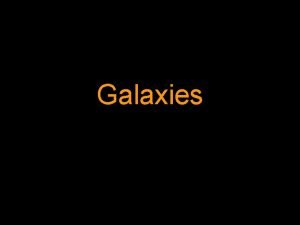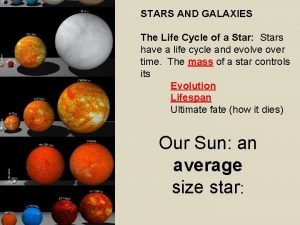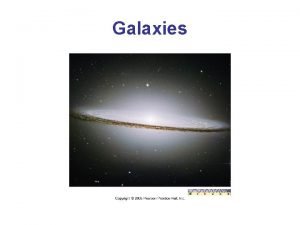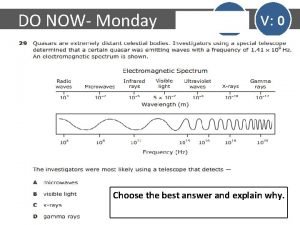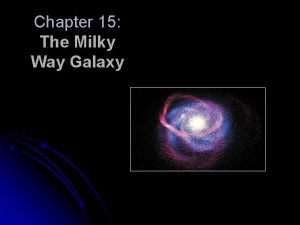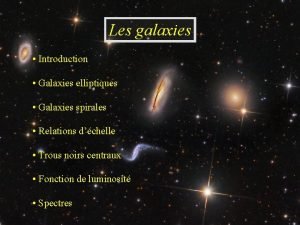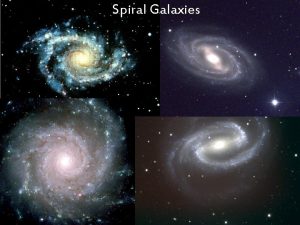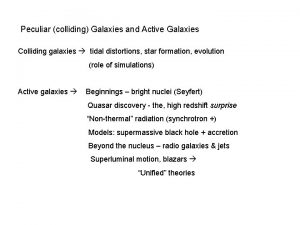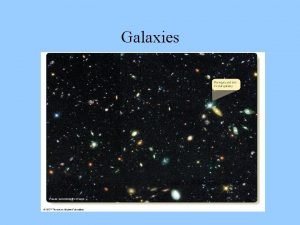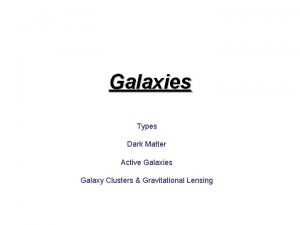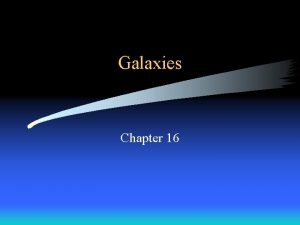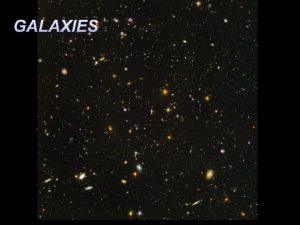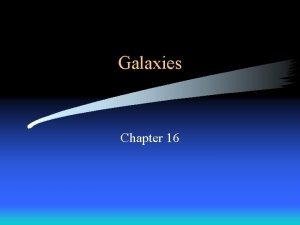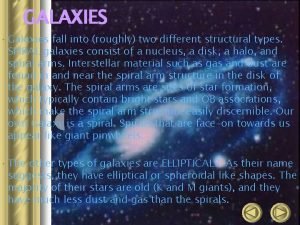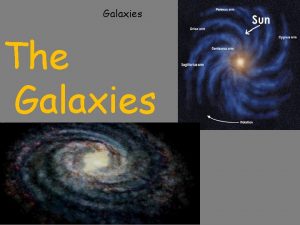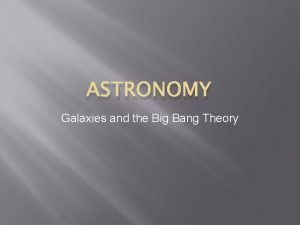4 Types of Galaxies Test 1 4 Types




























- Slides: 28

4 Types of Galaxies Test 1

4 Types of Galaxies 1. Spiral 2. Irregular 3. Elliptical 4. Lenticular A galaxy is a group of stars, dust and gas.

Spiral Galaxy 1. 2. 3. 4. The most common type of galaxy is called a "spiral galaxy. " Not surprisingly, spiral galaxies look like spirals, with long arms winding toward a bright bulge at the center. About 77% of the observed galaxies in the universe are spiral galaxies. Our own galaxy, the Milky Way, is a typical spiral galaxy




Elliptical Galaxies They are generally round but stretch longer along one axis than along the other. l Elliptical galaxies contain many older stars, up to one trillion, but little dust and other interstellar matter. l The universe's largest known galaxies are giant elliptical galaxies, which may be as much as two million light-years long. l




Irregular Galaxies l Approximately 3% of galaxies observed cannot be classified as either ellipsoidal or spirals. l These galaxies have little symmetry in their structure and are termed irregular galaxies.




Lenticular Galaxy l Lenticular galaxies are disc galaxies (like spiral galaxies) which have used up or lost most of their interstellar matter and therefore have very little ongoing star formation. l As a result, they consist mainly of aging stars and will produce the least amount of stars.




What are Constellations? • Constellations are named patterns of stars. All societies created them. • The classical -- "ancient" -- constellations that populate our sky began in the lands of the middle east thousands of years ago, their origins largely lost to time. • They passed through the hands of the ancient Greeks, who overlaid them with their legends and codified them in story and verse. • There are 88 named constellations

Orion If you look about due south around 9 p. m. your local time this week, you may see a familiar sight dominating our winter skies: the Great Hunter or Celestial Warrior, Orion, the most brilliant of the constellations and visible from every inhabited part of the Earth.

Red Supergiant Blue Supergiant

• The ancient mythological stories of Orion are so many and so confused that it is almost impossible to choose among them. • Probably the best known is the one where he got into trouble for bragging that no game could ever escape him. This annoyed the goddess Hera, who sent a poisonous scorpion (Scorpius) to sting his heel, and Orion subsequently died. • Orion, however, was brought back to life by the great physician, Aesculapius who got his medical secrets from the snakes. But the god Hades, King of the Dead, heard about this miraculous deed and became concerned about the future of his kingdom. • So he asked Zeus to intervene, and Zeus threw thunderbolts and liquidated both Orion and Aesculapius. As a precaution, Orion and the Scorpion were placed in opposite parts of the sky so they could never get into further trouble.

Canis Major-Sirius is the brightest star in the sky.

Big Dipper- Ursa Major

Follow the Drinking Gourd • The American folksong Follow the Drinking Gourd was first published in 1928. The Drinking Gourd song was supposedly used by an Underground Railroad operative to encode escape instructions and a map. These directions then enabled fleeing slaves to make their way north from Mobile, Alabama to the Ohio River and freedom. Taken at face value, the "drinking gourd" refers to the hollowed out gourd used by slaves (and other rural Americans) as a water dipper. But here it is used as a code name for the Big Dipper star formation, which points to Polaris, the Pole Star, and North.

Little Dipper- Ursa Minor The most famous star in Ursa Minor is Polaris, the North Star Polaris. North Star


 4 types of galaxies
4 types of galaxies What are galaxies
What are galaxies Waves are produced by stars and galaxies.
Waves are produced by stars and galaxies. Life cycle of galaxies
Life cycle of galaxies Elliptical galaxies facts
Elliptical galaxies facts E irregulars
E irregulars Era of galaxies
Era of galaxies Milky way galaxy shape
Milky way galaxy shape Chapter 30 galaxies and the universe
Chapter 30 galaxies and the universe Brainpop galaxies quiz answers
Brainpop galaxies quiz answers How are active galaxies classified?
How are active galaxies classified? How big is the galaxy
How big is the galaxy Tipus de galaxies
Tipus de galaxies Type of galaxy
Type of galaxy Evolution of galaxies
Evolution of galaxies Billions of galaxies
Billions of galaxies Galaxies lesson plan
Galaxies lesson plan Advantage of criterion-referenced assessment
Advantage of criterion-referenced assessment Www.123 test.com/disc-personality-test/
Www.123 test.com/disc-personality-test/ Latent squint meaning
Latent squint meaning Vike vicente
Vike vicente What is the ha
What is the ha Z test table
Z test table Univariate analysis tests
Univariate analysis tests Unpaired t test vs paired
Unpaired t test vs paired Butchery test is example of test to arrive at
Butchery test is example of test to arrive at When do we use z test or t test
When do we use z test or t test Parametric vs nonparametric tests
Parametric vs nonparametric tests Forced duction test procedure
Forced duction test procedure

